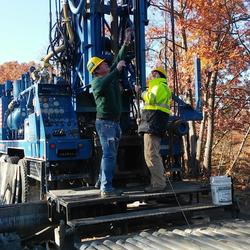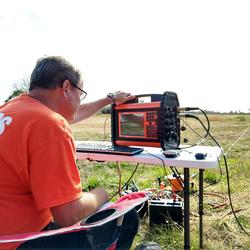Frederick Stumm
My projects have involved the application of hydrology, geology, and geophysics to environmental and engineering problems. They include delineating the extent of saltwater intrusion in coastal aquifers, mapping roadsalt plumes, detecting bridge scour, mapping hydrogeologic frameworks, delineating the fractured-rock groundwater system in Manhattan, and mapping depth to bedro
I hold a B.S. in Geology from Hofstra University, a M.S.. in Geology from California State University Fresno, and a Ph.D. in Earth and Environmental Science from the City University of New York Graduate Center. I take a multi-disciplinary approach applying Hydrology, Geology, and Geophysics with a focus on understanding the extent and mechanisms for saltwater intrusion on Long Island, the deposition of complex hydrogeologic frameworks, and quantifying fractured-rock groundwater flow. I recieved the Distinguished Scientific Achievement Award from the New York Federal Executive Board for my work on delineating the fractures, faults, foliation, and groundwater flow in Manhattan's bedrock using advanced borehole geophysical methods in support of the New York City Water Tunnel #3 Project. I have worked for the New York Water Science Center for over 20 years on studies that have helped coastal communities manage their water resources by delineating the extent of saltwater intrusion, improve construction safety and reduce cost overruns during construction of New York City Water Tunnel #3, the new Croton Water Filtration Tunnel, and the leakage in the Rondout West Branch Water Tunnel in Wawarsing NY, map the depth to bedrock in NYC, and delineated the extent of bridge scour at the Sloop Channel Bridge that lead to it's replacement. My ongoing projects include the delineation of the fractured-rock flow system in Wawarsing in support of the planned tunnel leakage repairs, the creation of the highest resolution bedrock maps for NYC in support of it's geothermal energy program, delineation of the saltwater-freshwater interface on Shelter Island NY, and remapping the hydrogeologic framework and delineation of saltwater intrusion throughout Long Island. My current research involves the application of radio signals transmitted between two wells to create two and three dimensional images of conductivity which can be used to map conductive plumes and possibly voids in bedrock.
Professional Experience
I have worked for the New York Water Science Center for over 20 years.
Education and Certifications
Ph.D. in Earth and Environmental Science from the City University of New York Graduate Center.
M.S.. in Geology from California State University Fresno.
B.S. in Geology from Hofstra University.
Science and Products
Geophysical and hydrologic analysis of an earthen dam site in southern Westchester County, New York Geophysical and hydrologic analysis of an earthen dam site in southern Westchester County, New York
Preliminary assessment of water chemistry related to groundwater flooding in Wawarsing, New York, 2009-11 Preliminary assessment of water chemistry related to groundwater flooding in Wawarsing, New York, 2009-11
Preliminary analysis of the hydrologic effects of temporary shutdowns of the Rondout-West Branch Water Tunnel on the groundwater-flow system in Wawarsing, New York Preliminary analysis of the hydrologic effects of temporary shutdowns of the Rondout-West Branch Water Tunnel on the groundwater-flow system in Wawarsing, New York
Geohydrologic assessment of fractured crystalline bedrock on the southern part of Manhattan, New York, through the use of advanced borehole geophysical methods Geohydrologic assessment of fractured crystalline bedrock on the southern part of Manhattan, New York, through the use of advanced borehole geophysical methods
Hydrogeology and Extent of Saltwater Intrusion in the Northern Part of the Town of Oyster Bay, Nassau County, New York: 1995–98 Hydrogeology and Extent of Saltwater Intrusion in the Northern Part of the Town of Oyster Bay, Nassau County, New York: 1995–98
Delineation of faults, fractures, foliation, and ground-water-flow zones in fractured-rock, on the southern part of Manhattan, New York, through use of advanced borehole-geophysical techniques Delineation of faults, fractures, foliation, and ground-water-flow zones in fractured-rock, on the southern part of Manhattan, New York, through use of advanced borehole-geophysical techniques
Hydrogeology and extent of saltwater intrusion on Manhasset Neck, Nassau County, New York Hydrogeology and extent of saltwater intrusion on Manhasset Neck, Nassau County, New York
Hydrogeology and extent of saltwater intrusion of the Great Neck peninsula, Great Neck, Long Island, New York Hydrogeology and extent of saltwater intrusion of the Great Neck peninsula, Great Neck, Long Island, New York
Delineation of tidal scour through marine geophysical techniques at Sloop Channel and Goose Creek bridges, Jones Beach State Park, Long Island, New York Delineation of tidal scour through marine geophysical techniques at Sloop Channel and Goose Creek bridges, Jones Beach State Park, Long Island, New York
Use of advanced borehole geophysical techniques to delineate fractured-rock ground-water flow and fractures along water-tunnel facilities in northern Queens County, New York Use of advanced borehole geophysical techniques to delineate fractured-rock ground-water flow and fractures along water-tunnel facilities in northern Queens County, New York
Use of advanced borehole geophysical techniques to delineate fractured-rock ground-water flow, faults, foliation, and fractures along the western part of Manhattan, New York Use of advanced borehole geophysical techniques to delineate fractured-rock ground-water flow, faults, foliation, and fractures along the western part of Manhattan, New York
Urbanization and recharge in the vicinity of East Meadow Brook, Nassau County, New York: Part 2 — Effect of urban runoff on the hydrology of the headwaters of East Meadow Brook, 1989-90 Urbanization and recharge in the vicinity of East Meadow Brook, Nassau County, New York: Part 2 — Effect of urban runoff on the hydrology of the headwaters of East Meadow Brook, 1989-90
Non-USGS Publications**
Bedrock on the Southern Part of Manhattan, New York, Using Advanced Borehole Geophysical Methods, American Geophysical Union Annual Fall Meeting, December 10-14, San Francisco, CA
saltwater intrusion within the Great Neck peninsula, New York, by use of geologic, hydrologic, and geophysical methods, in Geology of Long Island and Metropolitan New York, Programs with Abstracts, April 23, 1994, Stony Brook, New York
**Disclaimer: The views expressed in Non-USGS publications are those of the author and do not represent the views of the USGS, Department of the Interior, or the U.S. Government.
Groundwater Sustainability of the Long Island Aquifer System
Hydrogeologic-Framework Mapping - Long Island, New York
Saltwater-Interface Mapping - Long Island, New York
Delineation of the Saltwater-Freshwater Interface at Selected Well Locations in the Town of Riverhead, NY
Hydrogeology and Water Quality of the North Shore Aquifer in Locust Valley, Town of Oyster Bay, New York
Delineation of the Freshwater-Saltwater Interface at Selected Public-Supply Wells Using Advanced Surface and Borehole Geophysical Techniques, in Eastern Suffolk County, New York
Delineation of Groundwater Flow, Lithology, Faults, and Fractures Along Existing and Proposed Water Tunnel
Delineation of Rock Fractures, Faults, and Groundwater Flow in the Vicinity of Proposed Water Tunnels, New York City and Southeastern New York
Time Domain Electromagnetic Surveys Collected to Estimate the Extent of Saltwater Intrusion in Nassau and Queens County, New York, October-November 2017 Time Domain Electromagnetic Surveys Collected to Estimate the Extent of Saltwater Intrusion in Nassau and Queens County, New York, October-November 2017
Science and Products
Geophysical and hydrologic analysis of an earthen dam site in southern Westchester County, New York Geophysical and hydrologic analysis of an earthen dam site in southern Westchester County, New York
Preliminary assessment of water chemistry related to groundwater flooding in Wawarsing, New York, 2009-11 Preliminary assessment of water chemistry related to groundwater flooding in Wawarsing, New York, 2009-11
Preliminary analysis of the hydrologic effects of temporary shutdowns of the Rondout-West Branch Water Tunnel on the groundwater-flow system in Wawarsing, New York Preliminary analysis of the hydrologic effects of temporary shutdowns of the Rondout-West Branch Water Tunnel on the groundwater-flow system in Wawarsing, New York
Geohydrologic assessment of fractured crystalline bedrock on the southern part of Manhattan, New York, through the use of advanced borehole geophysical methods Geohydrologic assessment of fractured crystalline bedrock on the southern part of Manhattan, New York, through the use of advanced borehole geophysical methods
Hydrogeology and Extent of Saltwater Intrusion in the Northern Part of the Town of Oyster Bay, Nassau County, New York: 1995–98 Hydrogeology and Extent of Saltwater Intrusion in the Northern Part of the Town of Oyster Bay, Nassau County, New York: 1995–98
Delineation of faults, fractures, foliation, and ground-water-flow zones in fractured-rock, on the southern part of Manhattan, New York, through use of advanced borehole-geophysical techniques Delineation of faults, fractures, foliation, and ground-water-flow zones in fractured-rock, on the southern part of Manhattan, New York, through use of advanced borehole-geophysical techniques
Hydrogeology and extent of saltwater intrusion on Manhasset Neck, Nassau County, New York Hydrogeology and extent of saltwater intrusion on Manhasset Neck, Nassau County, New York
Hydrogeology and extent of saltwater intrusion of the Great Neck peninsula, Great Neck, Long Island, New York Hydrogeology and extent of saltwater intrusion of the Great Neck peninsula, Great Neck, Long Island, New York
Delineation of tidal scour through marine geophysical techniques at Sloop Channel and Goose Creek bridges, Jones Beach State Park, Long Island, New York Delineation of tidal scour through marine geophysical techniques at Sloop Channel and Goose Creek bridges, Jones Beach State Park, Long Island, New York
Use of advanced borehole geophysical techniques to delineate fractured-rock ground-water flow and fractures along water-tunnel facilities in northern Queens County, New York Use of advanced borehole geophysical techniques to delineate fractured-rock ground-water flow and fractures along water-tunnel facilities in northern Queens County, New York
Use of advanced borehole geophysical techniques to delineate fractured-rock ground-water flow, faults, foliation, and fractures along the western part of Manhattan, New York Use of advanced borehole geophysical techniques to delineate fractured-rock ground-water flow, faults, foliation, and fractures along the western part of Manhattan, New York
Urbanization and recharge in the vicinity of East Meadow Brook, Nassau County, New York: Part 2 — Effect of urban runoff on the hydrology of the headwaters of East Meadow Brook, 1989-90 Urbanization and recharge in the vicinity of East Meadow Brook, Nassau County, New York: Part 2 — Effect of urban runoff on the hydrology of the headwaters of East Meadow Brook, 1989-90
Non-USGS Publications**
Bedrock on the Southern Part of Manhattan, New York, Using Advanced Borehole Geophysical Methods, American Geophysical Union Annual Fall Meeting, December 10-14, San Francisco, CA
saltwater intrusion within the Great Neck peninsula, New York, by use of geologic, hydrologic, and geophysical methods, in Geology of Long Island and Metropolitan New York, Programs with Abstracts, April 23, 1994, Stony Brook, New York
**Disclaimer: The views expressed in Non-USGS publications are those of the author and do not represent the views of the USGS, Department of the Interior, or the U.S. Government.








